Reminiscing
 Many people have said they saw a flying saucer, and most have been laughed at, as the people they told about the flying saucer just couldn’t believe it was real. I’m not going to try to prove or disprove the flying saucer from outer space, but rather, I want to talk about the flying saucers of the United States Air Force. I can’t say if the flying saucers people have seen were actually the US Air Force’s Lenticular Reentry Vehicle, which was originally under research in the late 1950s. The Convair/Pomona division of General Dynamics initiated a project entitled Pye Wacket. The purpose of the project was to determine the feasibility of developing a missile-defense system based on flying discs…known as Lenticular vehicles. Although Pye Wacket was terminated by 1961, research had shown Lenticular-shaped vehicles possessed sound re-entry characteristics.
Many people have said they saw a flying saucer, and most have been laughed at, as the people they told about the flying saucer just couldn’t believe it was real. I’m not going to try to prove or disprove the flying saucer from outer space, but rather, I want to talk about the flying saucers of the United States Air Force. I can’t say if the flying saucers people have seen were actually the US Air Force’s Lenticular Reentry Vehicle, which was originally under research in the late 1950s. The Convair/Pomona division of General Dynamics initiated a project entitled Pye Wacket. The purpose of the project was to determine the feasibility of developing a missile-defense system based on flying discs…known as Lenticular vehicles. Although Pye Wacket was terminated by 1961, research had shown Lenticular-shaped vehicles possessed sound re-entry characteristics.
The project was classified as secret in 1962, but cleared for public information release December 28, 1999. It’s declassified technical report had been compiled by R J Oberto, Los Angeles Division of North American Aviation.  His report described the Lenticular Reentry Vehicle as an offensive weapons system. Popular Mechanics obtained information on the Lenticular Reentry Vehicle from a Freedom of Information Act request after documents describing the project were declassified in 1999. “The Lenticular Reentry Vehicle,” according to a November 2000 Popular Mechanics cover story, “was an experimental nuclear warhead delivery system under development during the Cold War by defense contractor North American Aviation, managed out of Wright-Patterson Air Force Base in Dayton, Ohio.” According to Oberto’s report, “the Lenticular Reentry Vehicle was a 40 foot half-saucer with a flat rear edge. The design-study documents indicated it could support a crew of four men for six-week orbital missions. Propulsion was from a rocket engine…either chemical or nuclear, and the craft would also have contained an onboard nuclear reactor for electrical power generation.”
His report described the Lenticular Reentry Vehicle as an offensive weapons system. Popular Mechanics obtained information on the Lenticular Reentry Vehicle from a Freedom of Information Act request after documents describing the project were declassified in 1999. “The Lenticular Reentry Vehicle,” according to a November 2000 Popular Mechanics cover story, “was an experimental nuclear warhead delivery system under development during the Cold War by defense contractor North American Aviation, managed out of Wright-Patterson Air Force Base in Dayton, Ohio.” According to Oberto’s report, “the Lenticular Reentry Vehicle was a 40 foot half-saucer with a flat rear edge. The design-study documents indicated it could support a crew of four men for six-week orbital missions. Propulsion was from a rocket engine…either chemical or nuclear, and the craft would also have contained an onboard nuclear reactor for electrical power generation.”
The existence of the Lenticular Reentry Vehicle program may bring credence to the idea of the military flying  saucers theory concerning unidentified flying objects, but the flight characteristics of the Lenticular Reentry Vehicle, as described by the documents released, are more similar to a standard orbital space capsule of the 1960s era, rather than the rapid motion and sudden velocity change characteristics of many reported UFOs. As of the publication of the Popular Mechanics article, there has been no official confirmation that the Lenticular Reentry Vehicle ever flew. Dynamic analysis of Lenticular missile configurations was conducted by the General Dynamics Pomona Division under Army Missile Command contract in the 1963. So, I guess the final decision goes to each person. Is it a UFO from outer space, or is it a Lenticular Reentry Vehicle (LRV) from the US Air Force?
saucers theory concerning unidentified flying objects, but the flight characteristics of the Lenticular Reentry Vehicle, as described by the documents released, are more similar to a standard orbital space capsule of the 1960s era, rather than the rapid motion and sudden velocity change characteristics of many reported UFOs. As of the publication of the Popular Mechanics article, there has been no official confirmation that the Lenticular Reentry Vehicle ever flew. Dynamic analysis of Lenticular missile configurations was conducted by the General Dynamics Pomona Division under Army Missile Command contract in the 1963. So, I guess the final decision goes to each person. Is it a UFO from outer space, or is it a Lenticular Reentry Vehicle (LRV) from the US Air Force?
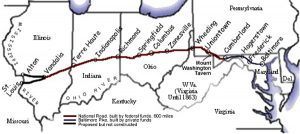
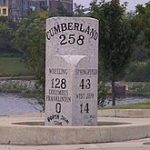 George Washington and Thomas Jefferson believed that a trans-Appalachian road was necessary to connect this young country. In 1806 Congress authorized construction of the road and President Jefferson signed the act establishing the National Road. It would connect Cumberland, Maryland to the Ohio River. Construction on the road, known in many places as Route 40, and in others as the Cumberland Road, began in 1811 and continued until 1834. It was designed to reach the western settlements, and was the first federally funded road in United States history.
George Washington and Thomas Jefferson believed that a trans-Appalachian road was necessary to connect this young country. In 1806 Congress authorized construction of the road and President Jefferson signed the act establishing the National Road. It would connect Cumberland, Maryland to the Ohio River. Construction on the road, known in many places as Route 40, and in others as the Cumberland Road, began in 1811 and continued until 1834. It was designed to reach the western settlements, and was the first federally funded road in United States history.
The first contract was awarded in 1811, and included the first 10 miles of road. These days that seems like such a short distance, but in the early 1800s, I’m sure it was considered a big job. By 1818 the road was completed to Wheeling, West Virginia. It was at this point that mail coaches began using the road. By the 1830s the federal government turned over part of the road’s maintenance responsibility to the states through which it ran. In order to help pay for the road’s upkeep, tollgates and tollhouses were built by the states. As work on the road progressed a settlement pattern developed that is still visible. Original towns and villages that were found along the National Road, remain barely touched by the passing of time. The road, also called the Cumberland Road, National Pike and other names, became Main Street in these early settlements, earning the nickname “The Main Street of America.” The height of the National Road’s popularity came in 1825 when it was celebrated in song, story, painting and poetry, but hard times hit in 1834, and construction on the road was tabled. During the 1840s popularity soared again. Travelers and drovers, westward bound, crowded the inns and taverns along the route. Huge Conestoga wagons hauled produce from farms on the frontier to the East Coast, and then returned with staples such as coffee and sugar for the western settlements. Thousands of people moved west in covered wagons and stagecoaches that traveled the road keeping to regular schedules.
In the 1870s, however, the railroads came and some of the excitement of the national road faded. In 1912 the road became part of the National Old Trails Road and its popularity returned in the 1920s with the automobile. Federal Aid became available for improvements in the road to accommodate the automobile. In 1926 the road became part of US 40 as a coast-to-coast highway. As the interstate system has grown throughout America, interest in the National Road again waned. However, now when we want to have a relaxing journey with some history thrown in, we again travel the National Road. Cameras capture old buildings, bridges and old stone mile markers. Old brick schoolhouses from early years sporadically dot the countryside and some are found in the small towns on the National Road. Many are still used, some are converted to a private residence and others stand abandoned.
Historic stone bridges dot their way along the National Road, and they have their own stories to tell. The craftsmanship of the early engineers was amazing. The S Bridge, was so named because of its design and it stands 4 miles east of Old Washington, Ohio. It was built in 1828 as part of the National Road. It is a single arch stone structure. This one of four in the state is deteriorated and is now used for only pedestrian traffic. However the owners of the bridge are attempting to obtain funding for its restoration. The stone Casselman River Bridge still stands east of Grantsville, Maryland. It is a product of the early 19th century federal government improvements program along the National Road, the Casselman River Bridge was constructed in 1813-1814. Its 80-foot span, is the largest of its type in America, and it connected Cumberland to the Ohio River. In 1933 a new steel bridge joined the banks of the Casselman River. The old stone bridge, partially restored by the State of Maryland in the 1950s is now the center of Casselman River Bridge State Park. Mile markers have been used in Europe for more than 2,000 years and our European ancestors continued that tradition here in America. These markers tell travelers how far they are from their destination and were an important icon in early National Road travel. Kids ask what they are fr, and adults nostalgically seek them out for photographing. A drive through National Road towns usually reveals one of these markers, such as the one standing by the historic Red Brick Tavern in Lafayette, Ohio.
In the 1960s Interstate 70, bypassed Route 40 and much of the National Road, leaving many businesses by the wayside. People were looking for faster cars and quicker arrival times. Life runs at a much faster pace these 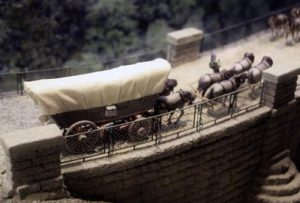
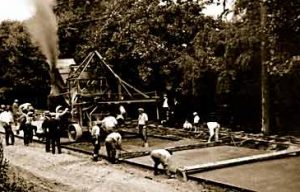 days. These old roads are a great way to relax, take your time and see some sights. Traveling the National Road, you can see the timeless little villages with small restaurants where you can get a home cooked meal and a trip back in time. The Interstate often parallels the National Road, but we leave behind the old inns and farmhouses in our rush to arrive about destination.
days. These old roads are a great way to relax, take your time and see some sights. Traveling the National Road, you can see the timeless little villages with small restaurants where you can get a home cooked meal and a trip back in time. The Interstate often parallels the National Road, but we leave behind the old inns and farmhouses in our rush to arrive about destination.
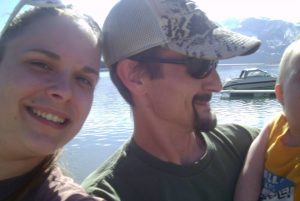 My niece, Cassie Iverson is a patient, loving mother of two beautiful children 6 year old Lucas, and 2 year old Zoey. She loves to go camping with the family, and they go as often as they can, because Cassie is a photographer, and is drawn to the beautiful side of life. Much of her photography is of nature, which appeals to me very much, as a nature lover too. Good photography requires an eye for staging. It’s strange to thing of staging the shot for nature, but things like what is centered, how much to zoom, and good lighting are vital to taking a great picture. Cassie has that eye for staging, and so her pictures come of beautiful and they draw you into the scene.
My niece, Cassie Iverson is a patient, loving mother of two beautiful children 6 year old Lucas, and 2 year old Zoey. She loves to go camping with the family, and they go as often as they can, because Cassie is a photographer, and is drawn to the beautiful side of life. Much of her photography is of nature, which appeals to me very much, as a nature lover too. Good photography requires an eye for staging. It’s strange to thing of staging the shot for nature, but things like what is centered, how much to zoom, and good lighting are vital to taking a great picture. Cassie has that eye for staging, and so her pictures come of beautiful and they draw you into the scene.
She takes pictures of her children and of other people too, and she has a great 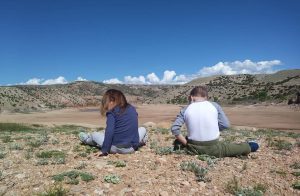 eye for staging those photos too, but her real love for photography lies in photographing nature. It makes perfect sense, since she loves to be camping more than living in town. She and her husband, Chris like to fish and camp out with the kids…showing them all the beauty that nature has to offer. While she loves photography, Cassie’s kids really are her whole heart.
eye for staging those photos too, but her real love for photography lies in photographing nature. It makes perfect sense, since she loves to be camping more than living in town. She and her husband, Chris like to fish and camp out with the kids…showing them all the beauty that nature has to offer. While she loves photography, Cassie’s kids really are her whole heart.
Her son, Lucas has had some medical issues over the past few years and so now the family is looking to move to a bigger city where the necessary medical facilities are available. They have looked in Montana, Colorado, and Tennessee. At this point, it looks like Tennessee might be the best place for them, so they are hoping to move sometime this summer. I know that many people in the family would rather have them in Montana or 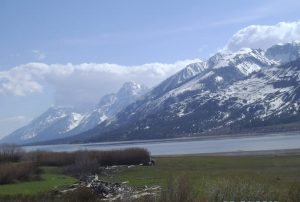 Colorado, but that may not be feasible. Time will tell I guess, and we will have to see where they land. Of course, if they move to Tennessee, we will all miss them, but thankfully Facebook can keep us in the loop with their lives. The most important thing for the family is to be near enough to good medical care for Lucas, so they don’t have to travel every time he needs surgery or other treatments. One thing that is for sure, this move, no matter where it takes them, will open up a whole new world of photography vistas for Cassie. I can’t wait to see the pictures she will take now. Today is Cassie’s birthday. Happy birthday Cassie!! Have a great day!! We love you!!
Colorado, but that may not be feasible. Time will tell I guess, and we will have to see where they land. Of course, if they move to Tennessee, we will all miss them, but thankfully Facebook can keep us in the loop with their lives. The most important thing for the family is to be near enough to good medical care for Lucas, so they don’t have to travel every time he needs surgery or other treatments. One thing that is for sure, this move, no matter where it takes them, will open up a whole new world of photography vistas for Cassie. I can’t wait to see the pictures she will take now. Today is Cassie’s birthday. Happy birthday Cassie!! Have a great day!! We love you!!
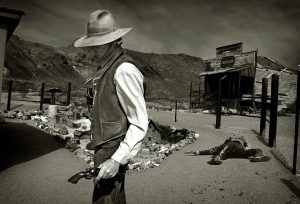 When we think of the outlaws of the old west, the term “gunfighter” or “gunslinger” were not the terms used to describe those men, or even the lawmen that some of them became upon changing their ways. They were actually originally called pistoleers, shootists, bad men, or one we do know…gunmen. That being said, Bat Masterson, who was a noted gunfighter himself, who later became a writer for the New York Morning Telegraph, sometimes referred to them as “gunfighters,” but, more often as “man killers.”
When we think of the outlaws of the old west, the term “gunfighter” or “gunslinger” were not the terms used to describe those men, or even the lawmen that some of them became upon changing their ways. They were actually originally called pistoleers, shootists, bad men, or one we do know…gunmen. That being said, Bat Masterson, who was a noted gunfighter himself, who later became a writer for the New York Morning Telegraph, sometimes referred to them as “gunfighters,” but, more often as “man killers.”
I suppose that Bat Masterson was probably the one who coined the term “gunfighter” in the first place, but many people from that era must have thought it an odd term to use. Still, if you heard an outlaw called a pistoleers, wouldn’t you have wondered what that was supposed to be? I would have, but then I would have looked it up and found that a pistoleers was “a soldier armed with a pistol.” That would have made no sense to me either, but in reality, some of the outlaws were soldiers who didn’t want to fight for a cause they didn’t believe in, so their deserted and headed west, so I guess they could have been pistoleers.
Another “movie mix-up” that happened is that in the old west, pistoleers or shootists didn’t squarely face off with each other from a distance in a dusty street, like they would like us to believe. In reality, the “real” gunfights of the Old West were rarely that “civilized.” Many fought in the many range wars and feuds of the Old West, which were far more common that the “stand-off” gunfight. Most of these were fought over land or water rights, some were political, and others were simply “old Hatfield-McCoy” style differences between families or in lifestyles. These people fought from the protection of anything available like a watering trough, a wall, building, or even a horse. Of those that more easily fit the perception of the “gunfighter,” you would find that they didn’t kill anywhere near the number of men they are credited with on television. In many instances their reputations stemmed from one particular fight, and the rumors grew from there, making people think they were that good. In other cases, self-promotion led people to believe they were lethal shootists, such was the case with Wyatt Earp and Wild Bill Hickok.
There were other, lesser known shootists, who actually saw just as much, if not more action than their well-known counterparts. Men like Ben Thompson, Tom Horn, Kid Curry, Timothy Courtright, King Fisher, Scott 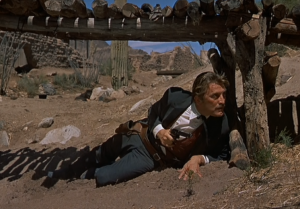 Cooley, Clay Allison, and Dallas Stoudenmire, just to name a few, were often not credited for nearly the shooting ability of the well known shooters. Often these gunfighters, whose occupations ranged from lawmen, to cowboys, ranchers, gamblers, farmers, teamsters, bounty hunters, and outlaws, were violent men who could move quickly from fighting one side of the law to the other, depending on what suited them best at the time. Though many of these gunman died of “natural causes,” many died violently in gunfights, lynchings, or legal executions. The average age of death was about 35. However, of those gunman who used their skills on the side of the law, they would persistently live longer lives than those that lived a life of crime.
Cooley, Clay Allison, and Dallas Stoudenmire, just to name a few, were often not credited for nearly the shooting ability of the well known shooters. Often these gunfighters, whose occupations ranged from lawmen, to cowboys, ranchers, gamblers, farmers, teamsters, bounty hunters, and outlaws, were violent men who could move quickly from fighting one side of the law to the other, depending on what suited them best at the time. Though many of these gunman died of “natural causes,” many died violently in gunfights, lynchings, or legal executions. The average age of death was about 35. However, of those gunman who used their skills on the side of the law, they would persistently live longer lives than those that lived a life of crime.
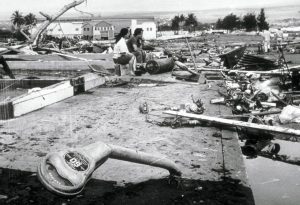 These days, scientist and inventors have collaborated to develop early warning systems for just about any possible disaster, and when everything works as it should, and people heed the warnings, loss of life can often be avoided. Having the technology is great, but technology can’t make human beings do the right things…unfortunately. On May 22, 1960, twelve years after tsunami warnings were developed, and with the warning system in good working order, a massive 9.5 earthquake struck off the coast of Chili. It was the largest earthquake ever recorded. Unfortunately, we don’t really have an earthquake warning, and so without warning, 1655 people lost their lives in Chili and 3,000 injured in the quake. Two million people were made homeless, and damage was estimated at $550 million. The earthquake, involving a severe plate shift, caused a large displacement of water off the coast of southern Chile at 3:11pm. Traveling at speeds in excess of 400 miles per hour, the tsunami moved west and north. On the west coast of the United States, the waves caused an estimated $1 million in damages, but were not deadly. Everyone assumed that the worst was over.
These days, scientist and inventors have collaborated to develop early warning systems for just about any possible disaster, and when everything works as it should, and people heed the warnings, loss of life can often be avoided. Having the technology is great, but technology can’t make human beings do the right things…unfortunately. On May 22, 1960, twelve years after tsunami warnings were developed, and with the warning system in good working order, a massive 9.5 earthquake struck off the coast of Chili. It was the largest earthquake ever recorded. Unfortunately, we don’t really have an earthquake warning, and so without warning, 1655 people lost their lives in Chili and 3,000 injured in the quake. Two million people were made homeless, and damage was estimated at $550 million. The earthquake, involving a severe plate shift, caused a large displacement of water off the coast of southern Chile at 3:11pm. Traveling at speeds in excess of 400 miles per hour, the tsunami moved west and north. On the west coast of the United States, the waves caused an estimated $1 million in damages, but were not deadly. Everyone assumed that the worst was over. 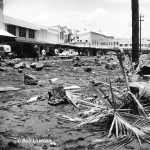
Nevertheless, warnings were sent to the Hawaiian islands. The Pacific Tsunami Warning System properly and warnings were issued to Hawaiians six hours before the wave’s expected arrival. The response of some people, however, was reckless and irresponsible. Some people ignored the warnings, and others actually headed to the coast in order to view the wave. Arriving 15 hours after the quake, only a minute after predicted, the tsunami destroyed Hilo Bay, on the island of Hawaii. Thirty five foot waves bent parking meters to the ground and wiped away most buildings, destroying or damaging more than 500 homes and businesses. A 10 ton tractor was swept out to sea. Reports indicate that the 20 ton boulders making up the sea wall were moved 500 feet. Sixty-one people died in Hilo, the worst-hit area of the island chain. Damage was estimated at $75 million. This tsunami caused little damage elsewhere in the islands, where wave heights were in the 3-17 foot range. The tsunami continued to race further west across the Pacific. Ten thousand miles away from the earthquake’s epicenter. Japan, received warning, but wasn’t able to warn the people in harm’s way. At about 6pm, more than a day after the quake, the tsunami hit the Japanese islands of Honshu and Hokkaido. The  crushing wave killed 180 people, left 50,000 more homeless and caused $400 million in damages. The Philippines, also hit, saw 32 people dead or missing.
crushing wave killed 180 people, left 50,000 more homeless and caused $400 million in damages. The Philippines, also hit, saw 32 people dead or missing.
Tsunami warnings definitely save lives, but only if people will heed the warnings. As long as people decide that the warning doesn’t apply to them, and give in to their curiosity to go have a look, there will continue to be deaths. It seems a great shame that inventors and scientist work so hard to make a warning to save lives, and then some people refuse to do what is necessary to be safe after they have been warned. I simply don’t understand how people can ignore these warnings and take a chance with their lives.
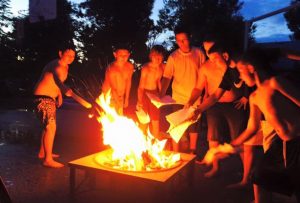
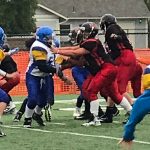 For my grandnephew, Xander Spethman, there is a specific tradition that goes along with his birthday every year. He gathers his friends together for a party. Now, I know that you are thinking, “What’s different about that?” Well, the difference is that they build a fire in his parents fire pit, and the boys burn their schoolwork from the year. Having a birthday so close to the end of the school year, it works out really well to have a school work burning party. This year will be slightly different, in that he will be burning the last year of his middle school career. As a boy, I don’t suppose that fact stirs up the emotions, like it does for his mom, but maybe it brings a bit of sadness that a certain time in his life has come to a close. Nevertheless, this has been a year of lasts. He has played his last middle school football game, and his last middle school basketball game. There will be a last time in the old school, and the last time (for awhile anyway) that he will be in school with his brother, Zack.
For my grandnephew, Xander Spethman, there is a specific tradition that goes along with his birthday every year. He gathers his friends together for a party. Now, I know that you are thinking, “What’s different about that?” Well, the difference is that they build a fire in his parents fire pit, and the boys burn their schoolwork from the year. Having a birthday so close to the end of the school year, it works out really well to have a school work burning party. This year will be slightly different, in that he will be burning the last year of his middle school career. As a boy, I don’t suppose that fact stirs up the emotions, like it does for his mom, but maybe it brings a bit of sadness that a certain time in his life has come to a close. Nevertheless, this has been a year of lasts. He has played his last middle school football game, and his last middle school basketball game. There will be a last time in the old school, and the last time (for awhile anyway) that he will be in school with his brother, Zack.
Of course, Xander is still very close with his family. He and his dad, Steve are best friends, and he is always so 
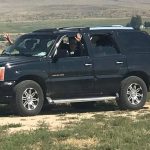 sweet to his mom, Jenny. He and his brothers, Zack and Isaac are also good friends, and his little sister, Aleesia is his little princess. His parents and siblings come to any and all his activities possible. It is a family tradition. Always be supportive of each other. Of course, that doesn’t mean that he and his brothers don’t fight, or that his sister never gets on his nerves, but Xander takes being the oldest very seriously. He works hard to be a leader and a good role model. And he does a good job of it too. His younger siblings look up to their brother and view him with a sense of pride. He shows them the right way to do things. Kids look up to their older siblings, and it is very important to make sure they are getting the right message from their older sibling, or they can end up in a lot of trouble down the road.
sweet to his mom, Jenny. He and his brothers, Zack and Isaac are also good friends, and his little sister, Aleesia is his little princess. His parents and siblings come to any and all his activities possible. It is a family tradition. Always be supportive of each other. Of course, that doesn’t mean that he and his brothers don’t fight, or that his sister never gets on his nerves, but Xander takes being the oldest very seriously. He works hard to be a leader and a good role model. And he does a good job of it too. His younger siblings look up to their brother and view him with a sense of pride. He shows them the right way to do things. Kids look up to their older siblings, and it is very important to make sure they are getting the right message from their older sibling, or they can end up in a lot of trouble down the road.
While this year is a year of lasts for Xander, it is also a year of firsts. This will be Xander’s first year of high school, Its a major change in a student’s life. Before long graduation will be right around the corner. This year has found Xander with a girlfriend, and to my knowledge, that is his first. He has signed up for ROTC, and I know he will do well with that, specially in the area of shooting accuracy, since Xander has been trained to be a great shot by his parents. Probably the biggest new thing in Xander’s life, however, will e the fact that since he 
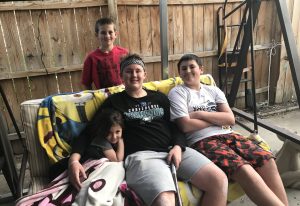 is now 15 years old, he will be getting his driver’s permit, so he can learn to drive. of course, his parents are excited to him to learn to drive, but they will also need to realize that they will most likely be relegated to the passenger side of the car…at least when Xander is in the car, because as we all know, 15 year olds need to drive!! There are a lot of changes coming his way, and we are so excited to see where life takes him next. Today is Xander’s 15th birthday. Happy birthday Xander!! Have a great day!! We love you!!
is now 15 years old, he will be getting his driver’s permit, so he can learn to drive. of course, his parents are excited to him to learn to drive, but they will also need to realize that they will most likely be relegated to the passenger side of the car…at least when Xander is in the car, because as we all know, 15 year olds need to drive!! There are a lot of changes coming his way, and we are so excited to see where life takes him next. Today is Xander’s 15th birthday. Happy birthday Xander!! Have a great day!! We love you!!
 My sister-in-law, Brenda Schulenberg became quite ill a number of years ago, and finally had to face the fact that her weight was slowly killing her. I suppose some people might think that statement is harsh, but they don’t know my sister-in-law. Those were fighting words for her, or at least a call to action. When she found out that her weight had caused sleep apnea and congestive heart failure, she decided that she was not going to let her weight win. From that day forward, the world would see a new Brenda…a determined Brenda.
My sister-in-law, Brenda Schulenberg became quite ill a number of years ago, and finally had to face the fact that her weight was slowly killing her. I suppose some people might think that statement is harsh, but they don’t know my sister-in-law. Those were fighting words for her, or at least a call to action. When she found out that her weight had caused sleep apnea and congestive heart failure, she decided that she was not going to let her weight win. From that day forward, the world would see a new Brenda…a determined Brenda.
The road was long, and filled with hard work. Brenda doggedly walked in the cold early morning hours, rain or shine, and even in snow. She bought a bicycle, and fought hard  to master that skill again, even with knees that had to be retrained to bent enough to work the pedals. In fact, when she started, Brenda had to take the pedals off and strider the bike (basically run while seated on a bicycle). It was work, but she wanted to ride a bicycle again, and determination goes a long way toward success. These days Brenda can be found riding her bicycle most days at some point in the day. She loves the Platte River Trail, and often rides its entire length.
to master that skill again, even with knees that had to be retrained to bent enough to work the pedals. In fact, when she started, Brenda had to take the pedals off and strider the bike (basically run while seated on a bicycle). It was work, but she wanted to ride a bicycle again, and determination goes a long way toward success. These days Brenda can be found riding her bicycle most days at some point in the day. She loves the Platte River Trail, and often rides its entire length.
Not only has Brenda continued to follow her own health and fitness plan, but she has chosen to mentor others. She has made several trips to attend meetings in other towns to talk to their weight loss groups, even if they are not on Weight Watchers, like  she is. She has put her name out there as someone who will buddy up with people who are struggling to lose weight to see if she can be on any encouragement or assistance. She is willing to go out and walk with them or ride bicycles with them too. She is so adamant about health, that she doesn’t want anyone to struggle with their health. I guess that since she has been on the unhealthy side of life, and the healthy side of life, and has chosen the healthy side of life, she wants others to be able to experience just how great it feels to be healthy…and she wants to help them to achieve their own health and fitness goals that have seemed so impossible to them. It is a noble calling. Today is Brenda’s birthday. Happy birthday Brenda!! Have a great day!! We love you!!
she is. She has put her name out there as someone who will buddy up with people who are struggling to lose weight to see if she can be on any encouragement or assistance. She is willing to go out and walk with them or ride bicycles with them too. She is so adamant about health, that she doesn’t want anyone to struggle with their health. I guess that since she has been on the unhealthy side of life, and the healthy side of life, and has chosen the healthy side of life, she wants others to be able to experience just how great it feels to be healthy…and she wants to help them to achieve their own health and fitness goals that have seemed so impossible to them. It is a noble calling. Today is Brenda’s birthday. Happy birthday Brenda!! Have a great day!! We love you!!
 As automobiles became commonplace…or at least more so than they had been, people began to realize that there needed to be some controls on their usage…specially in the area of speed. Most people know that is a car or other vehicle can go fast, there will always be someone out there, who wants to push the envelope and see just how fast it will go, throwing caution to the wind. With increased speeds would also follow, increased numbers of accidents. There would need to be some rules to follow.
As automobiles became commonplace…or at least more so than they had been, people began to realize that there needed to be some controls on their usage…specially in the area of speed. Most people know that is a car or other vehicle can go fast, there will always be someone out there, who wants to push the envelope and see just how fast it will go, throwing caution to the wind. With increased speeds would also follow, increased numbers of accidents. There would need to be some rules to follow.
There were already speed limits in the United States for non-motorized vehicles. In 1652, the colony of New Amsterdam, which is now New York, issued a decree stating that “[N]o wagons, carts or sleighs shall be run, rode or driven at a gallop” at the risk of incurring a fine starting at “two pounds Flemish,” or about $150 in today’s currency. In 1899, the New York City cabdriver Jacob German was arrested for driving his electric taxi at 12 miles per hour, but did the prior law really apply electric cars? It was becoming more and more obvious that some sort of legislation was necessary to ensure the safety of those operating these new machines, and those around them. So began the path to Connecticut’s 1901 speed limit legislation. Representative Robert Woodruff submitted a  bill to the State General Assembly proposing a motor-vehicles speed limit of 8 miles per hour within city limits and 12 miles per hour outside. While the law passed in May of 1901 specified higher speed limits, it required drivers to slow down upon approaching or passing horse-drawn vehicles, and come to a complete stop if necessary to avoid scaring the animals. I can’t imagine some of the restrictions listed there, because people would be stopped more than they were driving, but you have to start somewhere, and Connecticut was that starting point, when, on May 21, 1901 it became the first state to pass a law regulating motor vehicles, limiting their speed to 12 miles per hour in cities and 15 miles per hour on country roads.
bill to the State General Assembly proposing a motor-vehicles speed limit of 8 miles per hour within city limits and 12 miles per hour outside. While the law passed in May of 1901 specified higher speed limits, it required drivers to slow down upon approaching or passing horse-drawn vehicles, and come to a complete stop if necessary to avoid scaring the animals. I can’t imagine some of the restrictions listed there, because people would be stopped more than they were driving, but you have to start somewhere, and Connecticut was that starting point, when, on May 21, 1901 it became the first state to pass a law regulating motor vehicles, limiting their speed to 12 miles per hour in cities and 15 miles per hour on country roads.
Immediately following this landmark legislation, New York City went to work to keep up, and introduced the world’s first comprehensive traffic code in 1903. Adoption of speed regulations and other traffic codes was a slow and uneven process across the nation, however. As late as 1930, a dozen states had no speed limit, while 28 states did not even require a driver’s license to operate a motor vehicle. Rising fuel prices contributed to the lowering of speed limits in several states in the early 1970s, and in January 1974 President Richard Nixon 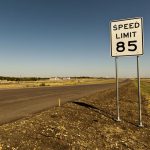 signed a national speed limit of 55 miles per hour into law. These measures led to a welcome reduction in the nation’s traffic fatality rate, which dropped from 4.28 per million miles of travel in 1972 to 3.33 in 1974 and a low of 2.73 in 1983.
signed a national speed limit of 55 miles per hour into law. These measures led to a welcome reduction in the nation’s traffic fatality rate, which dropped from 4.28 per million miles of travel in 1972 to 3.33 in 1974 and a low of 2.73 in 1983.
Concerns about fuel availability and cost later subsided, and in 1987 Congress allowed states to increase speed limits on rural interstates to 65 mph. The National Highway System Designation Act of 1995 repealed the maximum speed limit. This returned control of setting speed limits to the states, many of which soon raised the limits to 70 mph and higher on a portion of their roads, including rural and urban interstates and limited access roads.
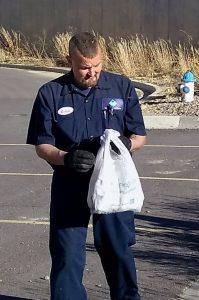 My nephew, Rob Masterson has been working at Sam’s Club in the Tire and Battery Center since August 1, 2017. Rob had not been able to work for some time, due to health issues brought on by his time in the service. The VA really wasn’t helpful to him, and after 4 plus years of waiting for them to decide on disability status, he’d had enough. Rob and his wife, Dustie were both unhappy with their current situation. Her job was not fulfilling, and they took her for granted. Then, Rob and Dustie basically stumbled on their jobs, and they will tell you that it was the best kind of accident to have. They were shopping at Sam’s club when they saw that Sam’s was hiring. They filled out the online application, and first Rob was called, and then Dustie. They were so excited to find that they would both be working at the same place. As Dustie puts it, “It’s amazing being able to work with your best friend. You know all the same people at work for the most part, and even though most people might find it weird to be able to discuss work and both know exactly what the other does, for us it’s just natural.” They did their orientation together, and both started on August 1, 2017. Rob actually started working before he completed the orientation, because his boss came in and said, “I need you now!” He would have to complete his orientation later. Rob, who has Rheumatoid Arthritis, was a little nervous about how his knees were going to handle the work, but he says that it hasn’t been too bad. Rob and Dustie prayed about his knees and ask for strength to be able to handle the work, and God answered their prayers.
My nephew, Rob Masterson has been working at Sam’s Club in the Tire and Battery Center since August 1, 2017. Rob had not been able to work for some time, due to health issues brought on by his time in the service. The VA really wasn’t helpful to him, and after 4 plus years of waiting for them to decide on disability status, he’d had enough. Rob and his wife, Dustie were both unhappy with their current situation. Her job was not fulfilling, and they took her for granted. Then, Rob and Dustie basically stumbled on their jobs, and they will tell you that it was the best kind of accident to have. They were shopping at Sam’s club when they saw that Sam’s was hiring. They filled out the online application, and first Rob was called, and then Dustie. They were so excited to find that they would both be working at the same place. As Dustie puts it, “It’s amazing being able to work with your best friend. You know all the same people at work for the most part, and even though most people might find it weird to be able to discuss work and both know exactly what the other does, for us it’s just natural.” They did their orientation together, and both started on August 1, 2017. Rob actually started working before he completed the orientation, because his boss came in and said, “I need you now!” He would have to complete his orientation later. Rob, who has Rheumatoid Arthritis, was a little nervous about how his knees were going to handle the work, but he says that it hasn’t been too bad. Rob and Dustie prayed about his knees and ask for strength to be able to handle the work, and God answered their prayers.
He applied for one transfer within the store, but didn’t get it and Dustie says, “I’m glad. When the position opened up to be the team lead over Tire Battery Center, I knew it was a perfect one for him.” I think they didn’t give him the first position, because they knew he was a great asset to the Tire and Battery Center, and they didn’t want to lose him. In the short time that Rob has worked at Sam’s, he has proven his worth. Dustie says that Rob is so nervous about being a supervisor again, but what he doesn’t realize that he is doing a great job. The people that he works with and the people that work for him have nothing but respect for him, and vice  versa. He treats everyone equally and with respect. You can see that he is so much happier…though more tired now, but she doesn’t think he will give it up…ever. He takes pride in his work and it shows. From sweeping the floor and taking out the trash to making sure the tires are correct in size and mounted properly. I think that Rob has always loved tinkering on cars, and so this was right up his alley.
versa. He treats everyone equally and with respect. You can see that he is so much happier…though more tired now, but she doesn’t think he will give it up…ever. He takes pride in his work and it shows. From sweeping the floor and taking out the trash to making sure the tires are correct in size and mounted properly. I think that Rob has always loved tinkering on cars, and so this was right up his alley.
Rob even has his special clients…the ones who ask for him, and who don’t want anyone else to work on their vehicle. One of them is a cute older woman who will not allow anyone else to work on her car, but Rob. Apparently her husband just recently passed away and he was the one who took care of everything on the car for her. When Rob helped her with her car, she was so relieved that someone truly cared, that she teared up. Dustie says, “I couldn’t be more proud of my husband. He is such a wonderful man and he’s making a lasting impression on this Earth and in Heaven. I couldn’t agree more. Today is Rob’s birthday. Happy birthday Rob!! Have a great day!! We love you!!
 My sister, Caryl Reed’s life has changed quite a bit over the last year, as she went from being a full-time respiratory therapist, to being a retired woman, who helps manage the rental business she and her husband, Mike have. Retirement looks good on Caryl. She is relaxed and enjoying the freedom her retirement has brought her. She has more time to spend with her grandchildren, Jaydn and Topher, and to plan the work that is coming up on their retirement ranch outside of Casper. The work on the ranch will be much easier when they don’t have to work things around her schedule, which included weekends, while Mike’s job doesn’t. Mike will be retiring in about five years and then they can move to Casper permanently…which is something we will all be happy about.
My sister, Caryl Reed’s life has changed quite a bit over the last year, as she went from being a full-time respiratory therapist, to being a retired woman, who helps manage the rental business she and her husband, Mike have. Retirement looks good on Caryl. She is relaxed and enjoying the freedom her retirement has brought her. She has more time to spend with her grandchildren, Jaydn and Topher, and to plan the work that is coming up on their retirement ranch outside of Casper. The work on the ranch will be much easier when they don’t have to work things around her schedule, which included weekends, while Mike’s job doesn’t. Mike will be retiring in about five years and then they can move to Casper permanently…which is something we will all be happy about.

As a young girl and into her adulthood, Caryl has loved horses, even taking riding lessons as a way to get her “Horse Fix” on. Having the ranch has given them the ability to have horses around them all the time. They board horses for people who do not have a place to keep their horses. They are always working on ways to improve the places for the horses to run, sleep, and be ridden. Their ranch is going to be great when they get the house built. Right now they have a garage, with an apartment on top, and a trophy room below for Mike’s hunting trophies. Caryl and Mike are designing their new home with all the 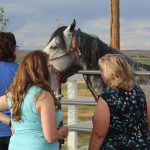 characteristics they like best.
characteristics they like best.
All this is a far cry from the little girl Caryl was. Her ticklish, giggling ways always made her the prime target for the “Tickle Torture” attacks that we, her sister very much loved to inflict upon her. I suppose there are people who might think we were mean to torture Caryl in such a way, but if you were ever a part of something like that, you would know that to attack someone as ticklish as Caryl is…well, it’s totally irresistible. In fact, having her back in Casper might be a really good thing for her torturers. Time will tell, I guess. Today is Caryl’s birthday. Happy birthday Caryl!! Have a great day!! We love you…really, we do!!

